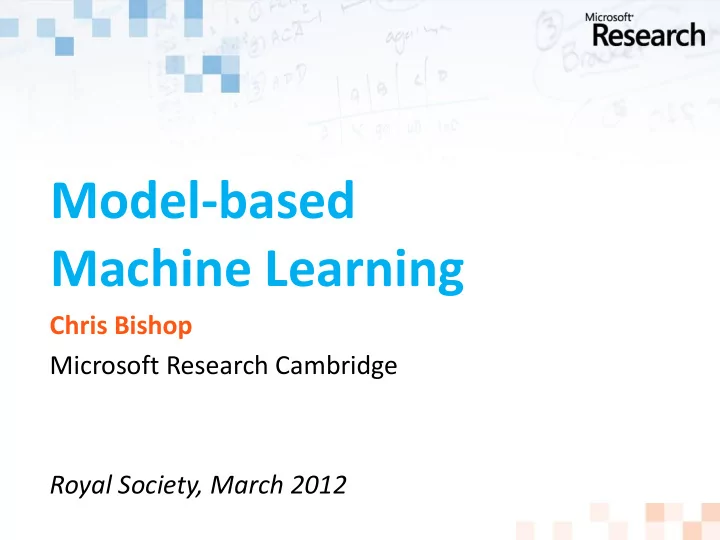

Model-based Machine Learning Chris Bishop Microsoft Research Cambridge Royal Society, March 2012
Traditional machine learning Logistic regression Neural networks K-means, mixture of Gaussians PCA, kernel PCA, ICA, FA Support vector machines Deep belief networks Decision trees and random forests … many others …
Model-based machine learning Goal : a single modelling framework which supports a wide range of models Traditional: “how do I map my problem onto a standard algorithm”? Model-based: “what is the model that represents my problem”?
Realisation of model-based ML Bayesian framework Probabilistic graphical models Efficient deterministic inference
Movie recommender demo
Probabilistic graphical models Maths (M) Geometry (G) Algebra (A) P (M, G, A) = P (M) P (G|M) P (A|M) Graph structure captures domain knowledge
Efficient inference
Local message-passing Maths (M) ? Geometry (G) Algebra (A)
What if distributions are intractable? True distribution Monte Carlo Variational Message Passing Loopy belief propagation Expectation propagation ⁞
Algorithms Models M. E. Tipping and C. M. Bishop (1997) C. M. Bishop (1999)
Childhood Asthma
Allergic Sensitisation Model
Comparison with traditional ML Separation of model and training algorithm Auto-generated inference algorithm Easy extension to more complex situations Modify model, use the same inference algorithms Flexible as requirements change Compact code Easy to write and maintain Transparent functionality Many traditional methods are special cases One simple framework for newcomers to the field
“Big data” Computational size vs. statistical size ? length temperature
Noisy ranking Conventional approach to ranking: “ Elo ” single strength value for each player cannot handle teams, or more than 2 players
Bayesian Ranking: TrueSkill TM s 1 s 2 1 2 y 12 R. Herbrich, T. Minka, and T. Graepel; NIPS (2006)
Multi-player multi-team model s 1 s 2 s 3 s 4 t 1 t 2 t 3 y 12 y 23
^ ^ s 1 s 2 s 1 s 2 1 2 1 2 ^ ^ ^ y 12 y 12
TrueSkill TM Sept. 2005; 10s of millions of users; millions of matches per day
Convergence 40 35 30 25 Level 20 15 char (TrueSkill ™ ) 10 SQLWildman (TrueSkill ™ ) char (Elo) 5 SQLWildman (Elo) 0 0 100 200 300 400 Number of Games
Infer.NET 1. Specify your machine learning problem as a probabilistic model in a .NET program (typically 10-20 lines of code). 2. Use Infer.NET to compile the model into optimized runtime code. 3. Run the code to make inferences on your data automatically. research.microsoft.com/infernet
research.microsoft.com/~ cmbishop
Recommend
More recommend